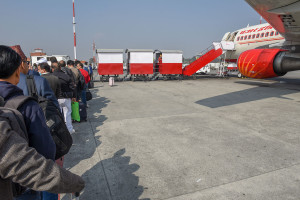Sun, Nov 30, 2025
Opinion
Diversity in power
There is need to re-think Nepal’s dependence on hydro-power and revise policy to add solar energy to the mix
bookmark
Jiwan Kumar Mallik & Ram Prasad Dhital
Published at : March 11, 2018
Updated at : March 11, 2018 08:28
As the country relies on a single power generation source of run-of-river hydropower which accounts for over 95 percent of the cumulative installed capacity of about 1GW, the state has been facing a steady power crisis since 2005. Since last year, Nepal made steady progress in easing load shedding in major cities, primarily through better load management and increasing electricity imports from India. Last year, Nepal imported more than 2,175GWh of power, an increase of 22.35 percent from the previous year, through its cross border transmission lines. However, this arrangement is not sustainable and is prone to risks and vulnerabilities. There is need of short, medium and long-term energy planning to have reliable, secure and sustainable electricity provided to households, businesses and industries in the country. There is also a need for a mix in power generation sources, and solar photo-voltaic (PV) plants can play a key role in obtaining this objective.
Diversity in power generation
There are many reasons why Nepal shouldn’t rely only on hydro generation. Due to the effects of climate change, river-flow is decreasing every year. Thus relying only on run-of-river hydropower may result in lower energy generated than expected. In of one of the micro-hydro plants that the Alternative Energy Promotion Centre (AEPC) supports, the existing turbine has been replaced by a turbine of lesser capacity (to achieve better efficiency) due to the decreased water flow. Further, civil structures account for around 60 percent of infrastructure in hydropower projects, which are more vulnerable to natural calamities like earthquakes and flash floods. The 2015 earthquake damaged several hydropower projects; cracks have been seen on the Kulekhani dam. According to the Post Disaster Need Assessment (PDNA) report, 115MW of hydropower facilities were severely damaged, amounting to damages worth Rs15,569 million. Also the flash flood of August 2014 damaged the 45MW Bhotekoshi Run-of-River (ROR) plant and many others. In the perspective of resilience to natural disasters, solar PV plants consist of less than 5 percent of civil structures, thus they are very less vulnerable to such natural calamities.
Simply from the perspective of generation management, solar energy can play an important role. Contrary to current trends, solar can be used as the daytime base load and Peak ROR can be saved for evenings (when demand spikes), thus leading to a decrease in imports. The necessity of diversifying the energy mix has also been emphasised by the “National Energy Crisis Mitigation Plan and Ten Year Electricity Development Plan 2016”, which has envisioned an energy scenario of 40-50 percent from reservoir-type or pump storage hydro, 15-20 percent from peaking run-of-river hydro, 25-30 percent from run-of-river and 5-10 percent from other renewable energy sources like solar/wind. This energy portfolio diversification is key for sustainable electricity supply. If there is a fall in one product, the other products can sustain supply.
Higher voltage lines (above 33kV) are congested and are unable to carry or inject more power, unless re-structuring or upgradation is carried out. The question, thus, is whether to upgrade the lines to 400kV and restructure them or to focus on distributed generation (DG). Centralised distribution is known to be affected by transmission and distribution losses, whereas a distributed system can be set up to transmit to regions near the sources. A recent study by NEA-Engineering Company on DG solutions for 753 local units shows that 221 local units of 192.6MW hydro, 481 local units of 481MWp Solar, 1 local unit of 0.2MWp Wind and 50 local units of 20.4MW biogas-based energy are feasible.
According to Water and Energy Commission Secretariat (WECS) data from 2014, residential load (mainly evening load) alone constitutes of more than 80 percent of total demand. In comparison, the industrial demand is prominent for developed nations. Since Nepal is also striving towards economic growth, it is certain that commercial and industrial demand, over residential, will be dominant in the future. Thus more daytime generation would be needed to cater to the daytime demand of commercial and industrial loads. A demand forecast study carried out by the Ministry of Energy shows that it will require about 3.6GW by 2020 and about 29.4GW of electricity by 2040 for an economic growth rate of 7.2 percent. In case of business as usual (BAU) scenario, it would require 3.3GW by 2020 and 19.1GW by 2040. It may not possible to cater the future demand of electricity even in the case of a BAU scenario if we rely only on hydro generation, which require five or more years to develop and construct. In comparison, solar PV can be developed and constructed within one to two years and would be a very good option alongside hydropower development to cater to the accelerated demand growth in Nepal.
Compared to the international scenario
According to REN21 Global Status Report, the total global installed capacity of solar PV was 303GW in 2016. Whereas India has achieved a milestone of 20GW of total solar PV installations by January 2018 with 9.26GW additions in 2017 itself, this high growth of solar PV among renewable energy technologies is also governed by the declining price of the solar technology.
In India, the lowest solar power tariff dropped to INR2.44/kWhr (approximately Rs4 per unit). However, this lowest tariff had been auctioned for 500MWp of projects in Rajasthan. Sadly, this low tariff in India is often compared to the Nepali market by policy makers and subject matter specialists. It is crucial to understand that the lower tariff in India is due to the economy of scale. One study carried out by the Asian Development Bank in Nepal pointed out that maximum of 20MWp can be injected into the country’s grid at a point because of a stability limit. The cost of a 20MWp Solar plant can’t be compared to that of on 500MWp in size. Secondly, in India the land acquisition and other infrastructure costs are much lower than in Nepal. Moreover in India, the developer gets the facility of road connectivity to each of plot of land, water availability for construction as well as running the power plant, construction power, transmission lines near the solar farm for power evacuation, parking, warehouses, tax holidays, accelerated depreciation and so on. No concrete steps have been taken by policy makers in Nepal to create such an enabling policy environment.
The local context
The recent “Grid Connected Alternative Energy Development Guideline 2074” published by Ministry of Energy (MoEn) has specified that Power Purchase Agreements (PPA) will adhere to a flat rate of Rs7.3/kWhr, with no provisions to increase this rate in future years. This rate was fixed by calculating the average current hydro-power rate. In the context of Nepal’s energy security and need for diversity in the generation mix, the PPA rate for solar should have been scientifically set rather than determined with hydro-centric thought. Nevertheless, the “Grid Connected Alternative Energy Development Guideline” can still be amended for wider promotion of Solar PV. With assumptions for the Nepali market, a recent study shows that the PPA rate of flat Rs7.3/kWhr shall only be feasible if the overall capital investment is below Rs70 million per MW of capacity. These costs are only possible in the current market for solar projects larger than 50MWp, which are not currently possible due to grid limitations. These policy hindrances are not allowing solar developers to gain financial confidence for developing and adding solar power into the grid in a short time span and thus contributing towards reducing import of electricity. It is time to think from the broader perspective of energy security and diversity of generation rather than the current hydro-centric planning, to create an enabling policy environment for swift development of solar PV generation to effectively supply the necessary electricity demand.
Dhital is Executive Director of Alternative Energy Promotion Center (AEPC) Nepal and Mallik is Solar Power Expert at the GoN, UNDP and GEF supported Renewable Energy for Rural Livelihood Programme; views expressed are personal
Editor's Picks
Floodlights. Camera. Action. Stage set for second NPL season
26 years after IC814 hijack, Nepal’s airport security still weak: Report
Ghising’s ties to new party spark debate
22 percent of Kathmanduites over 30 are diabetic
We might have to request people to contest elections on Nepali Congress ticket
E-PAPER | November 30, 2025
×




 9.12°C Kathmandu
9.12°C Kathmandu










